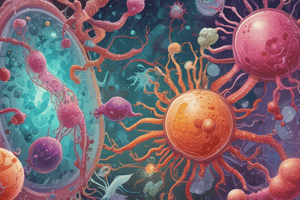Podcast
Questions and Answers
What is the primary role of a parasite in relation to its host?
What is the primary role of a parasite in relation to its host?
- Harm the host by living at its expense (correct)
- Live independently of the host
- Help the host maintain homeostasis
- Provide nutrients to the host
Which of the following correctly defines 'virulent' microorganisms?
Which of the following correctly defines 'virulent' microorganisms?
- Microorganisms that readily cause disease (correct)
- Microorganisms that cannot cause disease
- Microorganisms that require a large number to cause infection
- Microorganisms that live symbiotically with hosts
Which statement best describes Koch's Postulates?
Which statement best describes Koch's Postulates?
- They identify the symptoms associated with an infectious disease
- They confirm a microorganism as the causative agent of a disease (correct)
- They are criteria to evaluate the severity of a disease
- They define steps for pathogen transmission only
What must a pathogen do first in the steps of pathogenesis?
What must a pathogen do first in the steps of pathogenesis?
What type of microorganisms are referred to as 'opportunistic'?
What type of microorganisms are referred to as 'opportunistic'?
Which factor is known to promote the attachment of pathogenic microorganisms to host cells?
Which factor is known to promote the attachment of pathogenic microorganisms to host cells?
What is the definition of virulence in the context of infectious diseases?
What is the definition of virulence in the context of infectious diseases?
Which of the following is NOT considered a symptom of disease?
Which of the following is NOT considered a symptom of disease?
How do avirulent microorganisms differ from virulent microorganisms?
How do avirulent microorganisms differ from virulent microorganisms?
Which process does NOT occur during the disease pathogenesis of a pathogen?
Which process does NOT occur during the disease pathogenesis of a pathogen?
Flashcards
Host
Host
An organism that provides nutrients and a living environment for another organism.
Parasite
Parasite
An organism that lives at the expense of its host, often causing harm.
Disease
Disease
A disturbance in the normal functioning of an organism, resulting in noticeable changes.
Infectious disease
Infectious disease
Signup and view all the flashcards
Pathogen
Pathogen
Signup and view all the flashcards
Virulence
Virulence
Signup and view all the flashcards
Virulent
Virulent
Signup and view all the flashcards
Opportunistic
Opportunistic
Signup and view all the flashcards
Avirulent
Avirulent
Signup and view all the flashcards
Attenuated
Attenuated
Signup and view all the flashcards
Study Notes
Infection and Immunity
- Host: An organism that provides nutrients to another organism.
- Parasite: An organism that lives at the expense of its host, potentially harming it. Parasites are typically smaller and metabolically dependent on their host.
- Disease: A disruption of homeostasis in the host, resulting in observable changes.
- Symptom: A subjective indication of damage to the host (e.g., headache, anorexia).
- Sign: An objective indication of damage to the host (e.g., fever, rash, vomiting).
- Infectious Disease: A disease resulting from damage caused by a parasite.
- Pathogen: A microorganism capable of causing disease.
- Virulence: A measure of pathogenicity (ability to cause disease).
- Virulent: Microorganisms that readily cause disease; only a small amount needed to initiate and sustain infection.
- Opportunistic: Microorganisms that don't typically cause disease but can cause disease if they are introduced into a location where they're not usually found (like inside host tissues), even if they usually inhabit the host. These organisms are often part of the host's normal microbiota.
- Avirulent: Microorganisms that do not cause disease.
- Attenuated: Microorganisms with a reduced ability to cause disease.
Koch's Postulates
- If a microorganism is the causative agent of an infectious disease, it must:
- Be present in every case of the disease, but absent from healthy hosts.
- Be isolated and grown in pure culture.
- Cause the disease when a pure culture is introduced into a healthy host.
- Be re-isolated from the infected host.
Steps in Pathogenesis
- To cause disease, a pathogen must:
- Contact the host (be transmissible).
- Colonize the host (adhere and multiply on host surfaces).
- Infect the host (proliferate in host cells or tissues).
- Evade the host's defense system (avoiding contact that causes damage).
- Damage host tissues (physically or chemically).
Virulence Factors
- Factors that influence virulence in a microorganism:
- Adhesins: Promote attachment to host cells.
- Examples: pili used by Escherichia coli and Neisseria gonorrhoeae to attach to urethral cells. Salmonella and Escherichia coli use pili to attach to intestinal cells.
- Adhesins: Promote attachment to host cells.
Definition of Antigen and Antibody
- Antigen: Any substance capable of inducing an immune response when introduced into an organism.
- Antibody: A protein (immunoglobulin) produced by an organism in response to stimulation by an antigen.
Studying That Suits You
Use AI to generate personalized quizzes and flashcards to suit your learning preferences.




